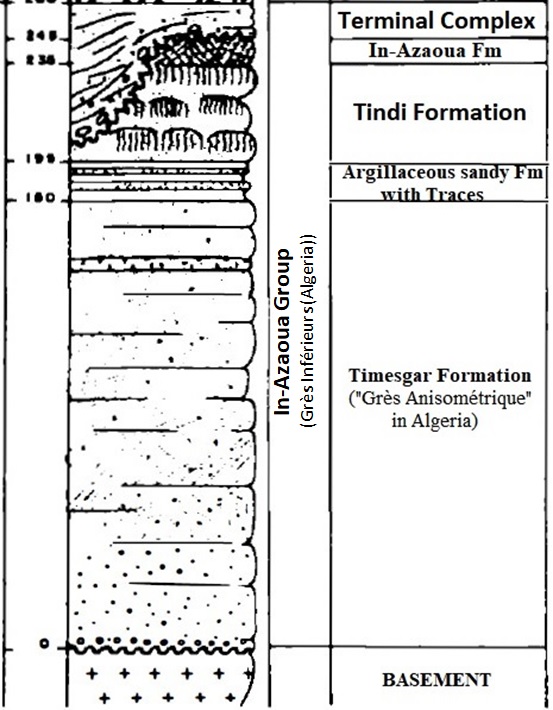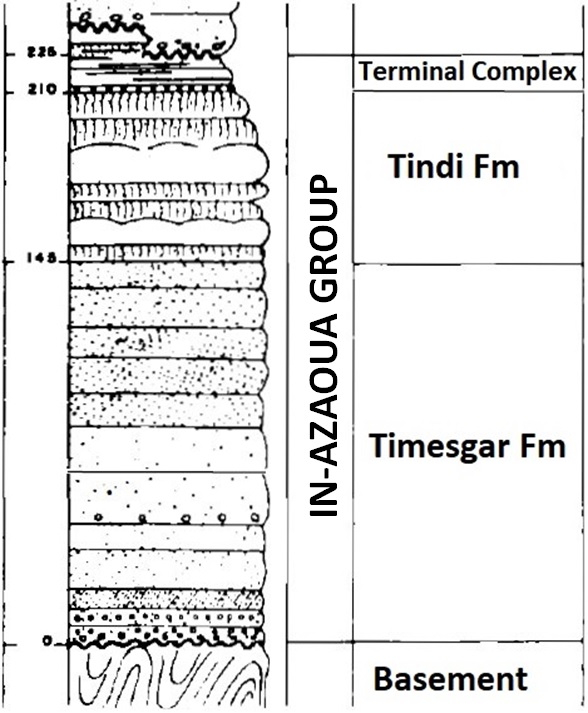In-Azaoua Gr
Type Locality and Naming
See approximate location of Sections #1, #2 and #3 of Claret & Tempère (1968) in Location Figure, and these same sections in the Figures of stratigraphic columns.
References: Claret & Tempère, 1968; Fabre et al., 1983; Abdoulaye et al., 2007.
Synonym: “Grès inférieurs du Tamesna"; Tamesna Lower Sandstones
[Figure 1. Map of the Tim Mersoï Sub-Basin and the Tin Séririne syncline showing the locations of the three sections studied by Claret & Tempère (1968) (Source: Map modified from Mammar, 2012).]
Lithology and Thickness
From surface field observations, this group was subdivided into five formations by Claret & Tempère (1968). The thickest and most complete sections are in the Tin Séririne syncline of Algeria (Fig. 1); the column then sees some units coming and going as it goes south and depending on the location within the Tim Mersoï Sub-Basin. From top to bottom (Fig. 3):
- Terminal complex [Complexe terminal] (approx. 25 m in thickness). In platelets, conglomeratic sandstones, coarse to fine, are characterized by their turbulent sedimentation. These sandstones rest on a surface of erosion with an amplitude that can reach 50 m. (Section #1 and #2 [Fig. 1 and 2]). It is possibly equivalent to the Ka Member of the Kandi Fm.
- Erosional surface
- In-Azaoua Fm (Sandstone) (“Grès d’In Azaoua”) resting on a slightly eroded surface. Coarser than the previous ones, they show oblique stratifications and contain rare tigillites [= tube-like trace-fossil, mainly found in Ordovician]. About 80 m thick in Niger (Section #1, #2 and #3 [Figures 1, 2 and 3])
- Tindi Fm in Niger (named by Abdoulaye et al., 2007) or Tigillites sandstones (Algeria). About 40 m in Algeria and 200 m in Niger of tigillite sandstone, medium to fine grain. It is often eroded in “dos d’éléphant” [elephant’s back] thus its frequent appellation of “grès pachydermiques” [Pachydermal sandstones] (Section #1, #2 and #3 [Figures 1, 2 and 3]).
- “Argillaceous sandy formation with Traces” (Synonym: Argilo-gréseux à Traces), about 15 m thick: alternation of silty clays and fine-grained sandstones displaying traces similar to Bilobites (a genus of brachiopods of small size) (Section #1 [Fig. 1]). Present only in Algeria in the Tin Séririne syncline.
- Timesgar Fm or "Grès de Timesgar" or “Grès Anisométrique”, about 180 m thick in Algeria and 100 m in Niger. It begins with a thick conglomerate (13 m) resting on the basement. Sandstones, coarse to fine, then overlay this conglomerate, often with oblique stratification (Section #1, #2, and #3 [Figures 1, 2 and 3]).
Maximum thickness of ~450 m.
[Figure 1. The complete In-Azaoua Group at Claret & Tempère (1968)’s section #1 location in Algeria (see Location Figure) (Source: Modified after Claret & Tempère, 1968).]
[Figure 2. The In-Azaoua Group at Claret & Tempère (1968)’s section #2 location (see Location Figure) (Modified after Claret & Tempère, 1968).]
[Figure 3. Sub-division of the Cambrian-Ordovician In-Azaoua Group west of the Aïr Massif between sections #2 and #3 of Claret & Tempère (1968) (Source: Modified after Abdoulaye et al., 2007).]
Relationships and Distribution
Lower contact
Precambrian is below
Upper contact
Overlain by the Graptolitic Shales Fm
Regional extent
GeoJSON
Fossils
Bilobites
Age
Depositional setting
Marine
Additional Information



